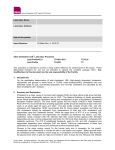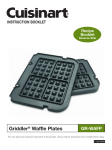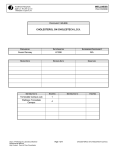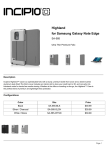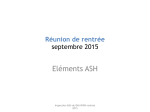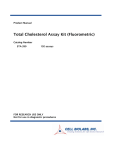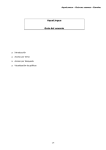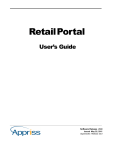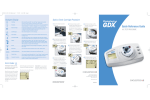Download Cholestex LDX Procedure
Transcript
BARNES-JEWISH Department of Laboratories St. Louis, MO 63110 HOSPITAL POINT-OF-CARE PROCEDURE POC 1.0225.01 Page 1 of 6 PROCEDURE: POC Lipid (Cholestech LDX) ISSUE DATE: March 2014 REVISION DATE: May 2015 PRINCIPLE: The Cholestech L.D.X. system combines enzymatic methodology and solid-phase technology to measure total cholesterol, HDL cholesterol, triglycerides, and glucose. Samples used for testing can be whole blood from a fingerstick (collected in a lithium heparin-coated capillary tube) or venipuncture. The sample is applied to a Cholestech LDX cassette. The cassette is placed into the Cholestech analyzer where a unique system on the cassette separates the plasma from the blood cells. A portion of the plasma flows to the right side of the cassette and is transferred to both the total cholesterol and triglyceride pads. Simultaneously, plasma flows to the left side of the cassette where the low-density lipoproteins are precipitated. The filtrate, containing both glucose and HDL is transferred to the glucose and HDL reaction pads where they are measured by an enzymatic method. The Cholestech LDX analyzer measures total cholesterol and HDL cholesterol by an enzymatic method based on the method formulation of Allain et al, and Roeschlau. Cholesterol esterase hydrolyzes the cholesterol esters in the filtrate or plasma to free cholesterol and the corresponding fatty acid. Cholesterol oxidase, in the presence of oxygen, oxidizes free cholesterol to cholest-4-ene-3-one and hydrogen peroxide. In a reaction catalyzed by horseradish peroxidase, the peroxide reacts with 4-Amnoantipyrine and N-Ethyl-N-sulfhydroxypropyl-m-toluidine, sodium salt (TOOS) to form a purple colored quinoneimne dye proportional to the total cholesterol and HDL cholesterol concentrations of the sample. CLINICAL SIGNIFICANCE: In the community setting, capillary blood monitoring will be used as a screening tool to determine blood values for total cholesterol, triglycerides, and blood glucose. SLCH Healthy Kids reports Cholesterol and Glucose Appropriately trained personnel shall perform this procedure using gloves and universal biohazard safety precautions. These persons will be required to demonstrate competency and proficiency periodically. EQUIPMENT: -Cholestech L.D.X. Lipid Analyzer -Power supply -Optics check cassette -User manual -Cholestech L.D.X. cassettes -Biohazardous waste containers -Alcohol wipes -Capillary tubes, capillary plungers -Gauze -Band-Aids -Latex and powder free gloves -Automatic lancet device and lancets -Quality control material -Blue pad and paper towels -Mini-pet pipette and pipette tips S:\CLINLAB\Point Of Care\procedures and documents\Healthy Kids Express - LeadCare and HemoCue\POC Cholestex LDX Procedure.doc BARNES-JEWISH Department of Laboratories St. Louis, MO 63110 HOSPITAL POINT-OF-CARE PROCEDURE POC 1.0225.01 Page 2 of 6 STORAGE and HANDLING Cassettes must be stored in the refrigerator after receipt. Cassettes may be used until the date printed on the pouch when stored in the refrigerator 2-8 degrees C. The cassettes may be stored for up to 30 days at room temperature. The new expiration date must be placed on the cassette box. Once the cassettes have been stored at room temperature they must not be returned to the refrigerator. Cassettes must warm up to room temperature, a minimum of 10 minutes before opening the foil pouch, before testing. Use the cassette as soon as the pouch is opened. SPECIMEN: Capillary whole blood samples obtained via fingerstick. Patient Preparation - Healthy Kids Express staff draws random (non-fasting) pediatric specimens. CALIBRATION: New Cholestech L.D.X. analyzers are calibrated against the laboratory chemical analyzer by running 5-10 patient samples in duplicate with a correlation coefficient of 0.90-1.10 as an acceptable variation before putting into use. Linearity levels (4 levels) are also ran in duplicate on new analyzers with sample setting at “serum”. Result sheets are sent to Cholestech for evaluation. PATIENT CORRELATIONS: Semi-annually, patient correlations and linearities are run on a representative group according to CAP regulations. For patient correlation studies, venous whole blood should be collected ONLY into a green-top tube (heparin anticoagulant). Whole blood should be used within 30 minutes. Mix all samples by inverting gently 7-8 times before testing. QUALITY CONTROL: Cassette Check: Check expiration date on Cholestech cassettes. Optics check procedure: Daily when Performing Patients 1. Check expiration date on the Optics Check (WARN 2 will appear on the screen if the Optic check has expired). 2. After verifying the self test OK message, press the RUN button. The drawer will open. This message will appear: “Load cassette and press RUN”. 3. Place the Optics Check Cassette into the cassette holder tray. Do not place any blood sample on the cassette. 4. Press the RUN button again and the system will automatically perform the Optics Check. Four numbers will appear on the display which relate to each channel in the instrument. 5. Record the Optics Check results in the Optics Check Log. Repeat if the ranges are not within the ranges on the The Optics cassette, if the OPTIC’s fail, contact SLCH Point of Care 454 4268 and do not do patient testing. S:\CLINLAB\Point Of Care\procedures and documents\Healthy Kids Express - LeadCare and HemoCue\POC Cholestex LDX Procedure.doc BARNES-JEWISH Department of Laboratories St. Louis, MO 63110 HOSPITAL POINT-OF-CARE PROCEDURE POC 1.0225.01 Page 3 of 6 Liquid Controls (Level 1 and Level 2 controls procedure): 1. Controls Level 1 and 2 must be run on each day of patient testing and on all new lot number or New shipment of cassettes before putting into use. 2. Controls are stored refrigerated at 2-8 degrees C. 3. Each vial has an unopened expiration date on it. After the vial has been opened it is good for 30 days. The vial must be dated and initialed when opened. If it is not dated it must be discarded. 4. Warm controls to room temperature, and check opened and unopened expiration dates before running. 5. Control ranges are listed on the Assay Sheet. 6. Mix quality control material well by gentle inversion before use, and follow the same procedure used for testing patients samples. Results outside acceptable control limits: 1. Pay careful attention to possible errors in technique. 2. Verify that the dating of the reagent cassette and quality control material has not been exceeded. 3. Retest the level(s) that is out of range, using a new sample from the same control vial: If the control is within acceptable limits, patient samples may be tested and reported. If the control is outside the acceptable limits, retest with a sample of control from a new Quality control vial. If the control is still outside the acceptable limits, contact SLCH Point of Care testing. Call 314 454 4268. Do not use the lipid analyzer for testing patient samples until issue has been resolved. Quality Control and patient testing procedures must be followed or results may not be accurate. MAINTENANCE: Daily: Clean the outside of the analyzer with a Super Sani Cloth Disposable Wipe. Do not immerse the analyzer in water or other cleaning fluid. Do no use any abrasive cleaners. Weekly: Clean the cassette holder tray with a cotton swab moistened with water, an alcohol solution, bleach, or disinfectant. Dry with a second cotton swab. PROCEDURE: Patient preparation and site selection: 1. The side of the palmar surface of the middle or ring finger of either hand is the preferred site. A site on the side at the end of the finger should be selected that has few nerve endings and is not calloused or scarred. The site should be warm to touch. Site preparation and Testing: 1. Have all of the following supplies in place before performing a fingerstick: a. Allow cassettes to sit unopened for at least 10 minutes to come to room temperature. b. Remove cassette from the pouch and place on a flat surface. Do not touch the magnetic strip or reaction bar. c. Insert capillary tube with plunger to red marking. d. Remove alcohol pad, Band-Aid, and gauze pad from package. e. A lancet inserted in a lancet sticking device is ready for use. 2. Apply gloves then gently massage the finger from the base to the tip several times to bring the blood to the tip of the finger. 3. Clean the site with an alcohol swab. Let the alcohol dry thoroughly. 4. Prick the selected site with the lancet. S:\CLINLAB\Point Of Care\procedures and documents\Healthy Kids Express - LeadCare and HemoCue\POC Cholestex LDX Procedure.doc Department of Laboratories St. Louis, MO 63110 BARNES-JEWISH HOSPITAL POINT-OF-CARE PROCEDURE POC 1.0225.01 Page 4 of 6 5. 6. 7. 8. 9. 10. 11. 12. 13. Wipe away the first drop of blood with gauze as it may contain excess tissue fluid. Gently press the area around the puncture site until a large drop of blood forms. Collect the sample in the capillary tube (avoid collecting air bubbles). The tube will fill to the black mark by capillary action. The capillary tube should not touch the skin. If necessary, gently massage the finger to obtain enough blood to fill the capillary tube. NOTE: Excess squeezing of the puncture site may cause hemolysis or dilute the sample with tissue fluid and may produce erroneous results. Have the client apply a clean gauze pad to the puncture site. Apply a Band-Aid. Within eight minutes dispense all of the blood from the capillary tube into the sample well in the center of the cassette. Press RUN and the drawer will open. The display will tell you to load the cassette and press RUN. Place the cassette in the holder tray with the reaction bar facing into the instrument. (The cassette must remain flat at all times after the sample has been placed inside the well. Do not touch the magnetic strip). Press RUN to close the drawer and start the test. Results will appear on the screen in about four minutes. Press DATA to show more results. Record the results on the client screening form. Cassettes are disposable and should not be reused. Dispose of the used cassette and other materials that have come in contact with the blood sample in a biohazardous waste container. The back-up instrument for the Cholestech L.D.X. meter is the other Cholestech L.D.X. when available on site. The SLCH Core Lab is the back up. A small green microtainer is required for testing in the Core Lab. REFERENCE INTERVALS: Cholesterol: < or = 19 years: <200 mg/dL Acceptable: <170 mg/dL Borderline: 170-199 mg/dL High: > or = 200 mg/dL > or = 20 years <240 mg/dL Acceptable: <200mg/dL Borderline: 200-239mg/dL High: >or=240mg/dl Literature Reference: National Cholesterol Education Program (NCEP) Expert Panel on Detection, Evaluation, and Treatment of High Blood Cholesterol in Adults (Adult Treatment Panel III). Circulation 2004; 110:227. Expert Panel on Integrated Guidelines for Cardiovascular Health and Risk Reduction in Children and Adolescents. Pediatrics 2011;128:S213 Critical Values No critical value established Glucose: Fasting : 0-3 days >3days 50 – 99 mg/dL 70 – 99 mg/dL Random: 0-3 days >3 days 50-110 mg/dL 70-199 mg/dL Critical Values: <18 years >18 years <40 or >400 mg/dL <50 or >450 mg/dL Literature Reference: Random glucose greater than or equal to 200 mg/dl with relevant clinical symptoms is diagnostic for diabetes when repeated on a subsequent day. Reference Diabetes Care 2005;28.S37-S42. Fasting glucose greater than or equal to 126 mg/dl and confirmed on a subsequent day of testing is diagnostic for diabetes. Fasting glucose greater than 100 mg/dl but less than 126 mg/dl indicates impaired glucose tolerance. Reference Diabetes Care 2005;28:S37-S42. S:\CLINLAB\Point Of Care\procedures and documents\Healthy Kids Express - LeadCare and HemoCue\POC Cholestex LDX Procedure.doc BARNES-JEWISH Department of Laboratories St. Louis, MO 63110 HOSPITAL POINT-OF-CARE PROCEDURE POC 1.0225.01 Page 5 of 6 Literature Reference: Expert panel on Integrated Guidelines for Cardiovascular Health and Risk Reduction in Children and Adolescents Pediatrics 2011;128:S213 National Cholesterol Education Program (NCEP) Expert Panel on Detection, Evaluation and treatment of High Blood Cholesterol in Adults (Adult Tratment Panel III). Circulation 20014;110 227 LINEARITY: Cholesterol: Glucose: 100-500 mg/dL <50-500 mg/dL DOCUMENTATION: 1. 2. 3. 4. Record optics check on the optics check log. Record level 1 and 2 control results on the quality control log. Record refrigerator temperature and room temperature on temperature logs. Record patient results on Healthy Kids Express patient log sheet. LIMITATIONS OF THE PROCEDURE: 1. 2. 3. 4. 5. 6. Hematocrits between 30 to 52% do not affect results. Blood collection tubes with glycerol should not be used for the triglyceride test. Hand creams and soaps with glycerol may cause falsely high triglyceride results. The message “Reaction did not occur” will appear on the instrumentation readout panel if sample was not applied correctly to the cassette or sample transfer failed. If the following environmental conditions are not met the Cholestech machine and the results will be adversely affected: a. Room temperature needs to be 68 to 82 degrees F. b. Relative humidity less than 85% c. Stable work surface, free from vibration. d. Isolation from direct heat sources. e. A grounded wall outlet supplying 120VAC that will be interrupted during use. IMPORTANT: Cholestech LDX instruments must be configured at “Whole Blood” mode for fingerstick or whole blood testing; and at “Serum” for serum or linearity level kit testing. This setting can be found by pressing “stop” then scroll through the menu by pressing “run” and changing the setting by pressing “data”. TROUBLESHOOTING: Refer to the Alere Cholestech LDX System User Manual or use the other LDX until problems have been resolved. Notify the SLCH Point of Care testing at 314 454 4268. REFERENCES: 1. Cholestech L.D.X. Lipid Analyzer User Manual and Procedure Manual 2011 S:\CLINLAB\Point Of Care\procedures and documents\Healthy Kids Express - LeadCare and HemoCue\POC Cholestex LDX Procedure.doc Department of Laboratories St. Louis, MO 63110 BARNES-JEWISH HOSPITAL POINT-OF-CARE PROCEDURE POC 1.0225.01 Page 6 of 6 Jennifer Moore MT(ASCP)/Donna Walck Point of Care Written By: ________________________________________________ Lab Manager/Technical Supervisor _______________________ Date ________________________________________________ Laboratory Medical Director _______________________ Date ________________________________________________ Medical Director (Individual lab area) _______________________ Date Annual Review: Medical Director/Designee Date ________________________________________________ _______________________ ________________________________________________ _______________________ ________________________________________________ _______________________ ________________________________________________ _______________________ ________________________________________________ _______________________ ________________________________________________ _______________________ ________________________________________________ _______________________ ________________________________________________ _______________________ Location of hard copy location(s): General Lab Policies & Point of Carel __________________________________ __________________________________ Date Archived: _______________________ S:\CLINLAB\Point Of Care\procedures and documents\Healthy Kids Express - LeadCare and HemoCue\POC Cholestex LDX Procedure.doc










